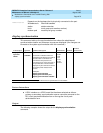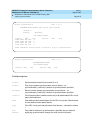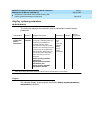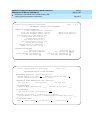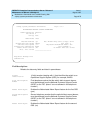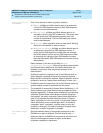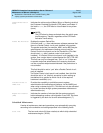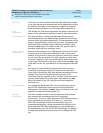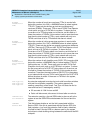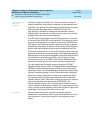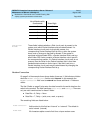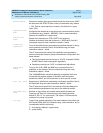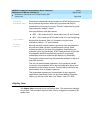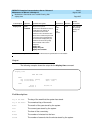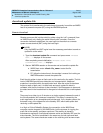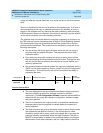
DEFINITY Enterprise Communications Server Release 6
Maintenance for R6vs/si
555-230-127
Issue 1
August 1997
Maintenance Commands and Trouble-Clearing Aids
Page 8-82display system-parameters maintenance
8
Minimum
Threshold for
TTRs
When the number of touch tone receivers (TTRs) in service falls
below this number (4 to 200), a WARNING alarm is raised against
TTR-LEV. These are also known as dual-tone multifrequency
receivers (DTMRs). There are 4 TTRs on each TN748 Tone Detector
circuit pack, and up to 50 TN748s in a system. To alarm the first
occurrence of a TTR being taken out of service, set this field to 4
times the number of TN748s. If this number is set to more than three
less than the total number of TTRs, a port network with only one
TN748 could lose all of its TTRs before this alarm is raised.
Minimum
Threshold for
CPTRs
When the number of call progress tone receivers in service falls
below this number (2 to 100), a WARNING alarm is raised against
TTR-LEV. These are also known as general purpose tone detectors
(GPTDs). There are 2 CPTRs on each TN748 Tone Detector circuit
pack, and up to 50 TN748s in a system. To alarm the first
occurrence of a CPTR being taken out of service, set this field to 2
times the number of TN748s. If this number is set to more than one
less than the total number of TTRs, a port network with only one
TN748 could lose all of its CPTRs before this alarm is raised.
Minimum
Threshold for
Call Classifier
Ports
When the number of call classifier ports (CLSFY-PTs) in service falls
below this number, a WARNING alarm is raised against TTR-LEV.
Valid entries are 1 to 200. There are 8 ports on each TN744 Call
Classifier circuit pack, and up to 25 TN744s in a system. To alarm
the first occurrence of a CLSFY-PT being taken out of service, set
this field to 8 times the number of TN744s. If this number is set to
more than 7 less than the total number of CSLFY-PTs in the system,
a port network with only one TN744 could lose all of its CLSFY-PTS
before the alarm is raised. If there are no TN744s in the system,
leave this field blank.
Test Type 100,
Test Type 102,
Test Type 105
An extension assigned to receive tie-trunk calls from other switches
with test line origination capability. The system responds by
sending a sequence of test tones. Test Type 100 tests far-end to
near-end loss and C-message by sending:
■ 5.5 seconds of 1004 Hz tone at 0dB
■ Quiet until disconnect; disconnect is forced after one minute
ISDN-PRI Test
Call Extension
The extension used by a far-end ISDN node to place a call to the
system to test the ISDN-PRI trunks between the far-end and the
system.
ISDN-BRI
Service SPID
This field shows whether or not the link is associated with the
Service SPID. If the link is associated with the Service SPID, this
field contains a “yes” and the extension field is blank; otherwise,
this field is blank. Service SPID is a feature used by the system
technician to check building wiring between the switch and the BRI
endpoint.



